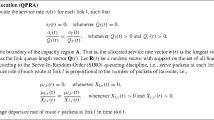Abstract
In this paper, we consider a radio-based communication network in which a single, high speed radio channel is shared by some plurality of small portable “notebooks”. Such a system has the potential to provide LAN-like service within buildings, allowing the portable "notebooks" to access the CPU and data resources of a wired network. In this harsh indoor fading environment, a base-station approach is used. We propose a modified polling scheme for the indoor radio LAN channel. The base station regularly polls each remote, in response to which the remote either generates a "keep alive" packet or a request packet, allowing the base to fetch the requested information from the wired network and scheduling a reply to that remote. The efficiency of such a scheme is studied and the expected turn-around delay as a function of network loading is approximately obtained. A system stability under such a scheme is derived. For a polling cycle of 20 milliseconds and a network containing 10 or 50 users, for example, the maximum link efficiency is 97% and 87%, respectively, assuming that the link speed is 5 Mbps.
Similar content being viewed by others
References
D. Goodman, Cellular packet communications, IEEE Trans. Commun. COM-38(1990)1272–1280.
B.J. Mallinder, An overview of the GSM system,3rd Nordi Semi. Digital Land Mobile Radio Commun., Copenhagen, Denmark (1988) pp. 3.1.1–3.1.13.
R.S. Swain and A.J. Motley, Requirements of an advanced cordless telecommunication product,Proc. 1987 Int. Communications Conf., Seattle, WA (June, 1987) pp. 81–85.
D.C. Cox, Universal digital portable radio communications, Proc. IEEE 75(1987)436–477.
R. Khayata, Chia-Chi Huang and Nadim Al-Jawhary, unpublished work.
H. Takagi,Analysis of Polling Systems (MIT Press, Cambridge, MA, 1986).
H. Takagi, A survey of queueing analysis of polling systems,Proc. 3rd Int. Conf. on Data Communications Systems and Their Performance, Rio de Janeiro (1987).
A.S. Acampora and J.H. Winters, System applications for wireless indoor communications, IEEE Commun. Mag. 25, no. 8(1987)11–20.
A.S. Acampora and J.H. Winters, A wireless network for wide-band indoor communications, JSAC 5(1987)796–805.
L. Takács,Introduction to the Theory of Queues (Oxford University Press, New York, 1962).
M.J. Maron,Numerical Analysis. A Practical Approach (Macmillan, New York, 1987).
E. Činlar,Introduction to Stochastic Processes (Prentice-Hall, 1975).
L. Kleinrock,Queueing Systems, vol. 1 (Wiley, New York, 1975).
Author information
Authors and Affiliations
Additional information
The Center for Telecommunications Research is an NSF Engineering Research Center. This work was supported under NSF grant #ECD88-1 1111.
Rights and permissions
About this article
Cite this article
Zhang, Z., Acampora, A.S. Performance of a modified polling strategy for broadband wireless lans in a harsh fading environment. Telecommunication Systems 1, 279–294 (1993). https://doi.org/10.1007/BF02136165
Received:
Revised:
Issue Date:
DOI: https://doi.org/10.1007/BF02136165




